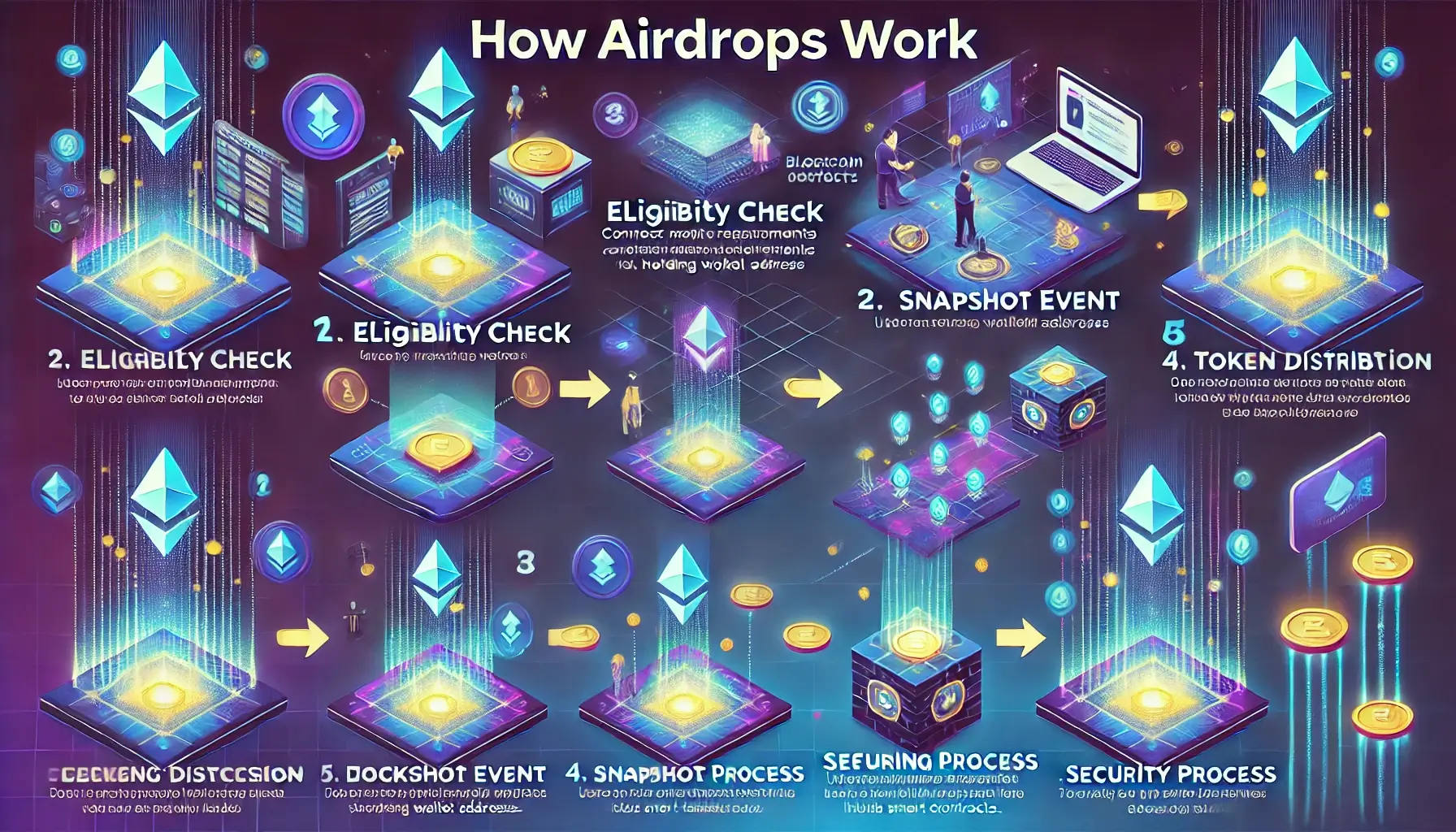Have you ever received free crypto tokens and wondered how they ended up in your wallet? Or have you come across projects promoting crypto airdrops and wanted to know how they function? How airdrops work is a common question among crypto enthusiasts, and understanding the crypto airdrop mechanism is key to safely and effectively participating in these giveaways.
Airdrops are a strategic way for blockchain projects to distribute tokens, whether to reward loyal users, decentralize token ownership, or promote new developments. But how does this process actually work? What are the different ways tokens are distributed, and how can you maximize your earnings while avoiding scams?
In this guide, we’ll break down the token distribution process, explore the most common crypto airdrop mechanisms, and provide essential security tips to ensure you take advantage of these opportunities safely.
Why Do Crypto Projects Use Airdrops?
1. Increase Awareness and Adoption
New blockchain projects use airdrops to attract attention and build an initial user base. Free tokens incentivize people to explore the platform and get involved.
2. Reward Early Supporters and Holders
Some airdrops are designed to reward long-term investors or active users who have supported a project from its early stages. These rewards strengthen community loyalty.
3. Decentralize Token Ownership
Instead of a few investors controlling the supply, airdrops help distribute tokens among a broader audience, making the project more decentralized and robust.
4. Encourage Community Engagement
Airdrops often require participants to follow social media accounts, share posts, or join Telegram groups, boosting the project’s visibility and engagement.
How Airdrops Work: Token Distribution Methods
Understanding how airdrops work requires knowing the different distribution models used by projects. Here are the most common crypto airdrop mechanisms:
1. Standard Airdrops
- Users receive free tokens without needing to complete any tasks.
- The project may randomly select users or require them to register their wallet address.
- Example: Some DeFi platforms distribute governance tokens to early adopters.
2. Task-Based Airdrops
- Participants complete specific actions (e.g., retweeting a post, subscribing to a newsletter, or joining a Telegram group).
- More tasks usually mean more rewards.
- Example: NFT and gaming projects frequently use task-based airdrops to grow their communities.
3. Holder-Based Airdrops
- Tokens are distributed to users who hold a specific cryptocurrency at a predetermined “snapshot” date.
- The number of tokens received is proportional to the amount held.
- Example: XRP holders received Spark (FLR) tokens in 2020.
4. Hard Fork Airdrops
- When a blockchain undergoes a split (hard fork), token holders receive an equivalent amount of the new token.
- Example: Bitcoin holders received Bitcoin Cash (BCH) after the BTC/BCH fork.
5. Staking and Governance Airdrops
- Users who stake tokens on a platform or participate in governance decisions are rewarded with additional tokens.
- Example: Platforms like Uniswap and Aave distribute governance tokens to active users.
How to Participate in Airdrops Safely
1. Use a Separate Wallet for Airdrops
2. Never Share Your Private Keys
- Legitimate airdrops will never ask for your private keys or seed phrase. If they do, it’s a scam.
3. Verify the Project’s Legitimacy
- Always research the project’s official website, social media presence, and token listings on CoinMarketCap or CoinGecko.
4. Avoid Fake Airdrop Tokens
- Some scams involve sending fake tokens to wallets and tricking users into interacting with malicious smart contracts.
5. Stay Updated with Trusted Airdrop Platforms
- Follow websites like FreeCoins24 to find verified and safe airdrop listings.
Frequently Asked Questions (FAQ)
1. What is a crypto airdrop?
A crypto airdrop is a free distribution of tokens by a blockchain project to promote adoption, reward users, or decentralize ownership.
2. How do airdrops work?
Tokens are distributed through various methods, including standard airdrops, task-based airdrops, and holder-based distributions.
3. Are airdrops free?
Yes, legitimate airdrops do not require payment. However, users may need to complete small tasks or pay minimal transaction fees to claim tokens.
4. How can I find active airdrops?
Platforms like FreeCoins24 and CoinMarketCap list active and upcoming airdrop opportunities.
5. Can I join multiple airdrops?
Yes! Participating in multiple airdrops increases your chances of earning valuable rewards.
6. Are airdrops taxable?
Tax laws vary by country. Some jurisdictions classify airdrop tokens as taxable income, so check local regulations.
7. How do I avoid airdrop scams?
- Never share private keys.
- Verify the project’s authenticity.
- Avoid clicking on suspicious links.
Conclusion
Understanding how airdrops work is essential for anyone looking to earn free tokens while staying safe in the crypto space. Whether through task-based airdrops, holder-based distributions, or staking rewards, knowing the different crypto airdrop mechanisms will help you maximize your opportunities.
By following security best practices and staying informed with reliable sources, you can take advantage of crypto airdrop opportunities while minimizing risks.
Want to find the best airdrops? Check out these trusted platforms:
 Limited Time Offer: Claim Up to $30,000 Now!
Get started
Limited Time Offer: Claim Up to $30,000 Now!
Get started





